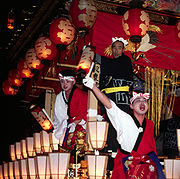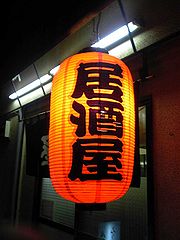
Traditional lighting equipment of Japan
Encyclopedia



Bonbori
The is a kind of Japanese paper lamp used in the open. It normally has an hexagonal profile and is used during festivals. It can either hang from a wire or stand on a pole. Famous is the , held annually at Tsurugaoka Hachiman-gū in Kamakura, Kanagawa. Artists paint on the about 400 bonbori erected...
(雪洞), the chōchin (提灯), and the tōrō
Tōrō
A "灯篭" is just a simplified form of "灯籠". is a Japanese lantern made of stone, wood, or metal traditional in the Far East. In China extant specimen are very rare, and in Korea too they are not as common as in Japan. In Japan, tōrō were originally used only in Buddhist temples, where they lined and...
(灯篭).
Andon
The andon is a lamp consisting of paperPaper
Paper is a thin material mainly used for writing upon, printing upon, drawing or for packaging. It is produced by pressing together moist fibers, typically cellulose pulp derived from wood, rags or grasses, and drying them into flexible sheets....
stretched over a frame of bamboo, wood or metal. The paper protected the flame from the wind. Burning oil in a stone or ceramic holder, with a wick of cotton, provided the light. Rapeseed
Rapeseed
Rapeseed , also known as rape, oilseed rape, rapa, rappi, rapaseed is a bright yellow flowering member of the family Brassicaceae...
oil was popular. Candles were also used, but their higher price made them less popular. A lower-priced alternative was sardine
Sardine
Sardines, or pilchards, are several types of small, oily fish related to herrings, family Clupeidae. Sardines are named after the Mediterranean island of Sardinia, around which they were once abundant....
oil.
The andon became popular in the Edo period
Edo period
The , or , is a division of Japanese history which was ruled by the shoguns of the Tokugawa family, running from 1603 to 1868. The political entity of this period was the Tokugawa shogunate....
. Early on, the andon was handheld; it can also be placed on a stand or hung on a wall. The okiandon was most common indoors. Many had a vertical box shape, with an inner stand for the light. Some had a drawer on the bottom to facilitate refilling and lighting. A handle on top made it portable. A variety was the Enshū andon. One explanation attributes it to Kobori Enshu, who lived in the late Azuchi-Momoyama Period
Azuchi-Momoyama period
The came at the end of the Warring States Period in Japan, when the political unification that preceded the establishment of the Tokugawa shogunate took place. It spans the years from approximately 1573 to 1603, during which time Oda Nobunaga and his successor, Toyotomi Hideyoshi, imposed order...
and early Edo period. Tubular in shape, it had an opening instead of a drawer. Another variety was the Ariake andon, a bedside lamp. The kakeandon under the eaves of a shop, often bearing the name of the merchant, was a common sight in the towns.
The expression hiru andon, or "daytime lamp," meant someone or something that seemed to serve no purpose. In dramatizations of the story of the forty-seven ronin
Forty-seven Ronin
The revenge of the , also known as the Forty-seven Samurai, the Akō vendetta, or the took place in Japan at the start of the 18th century...
, Oishi Yoshio
Oishi Yoshio
was the chamberlain of the Akō Domain in Harima Province , Japan . He is known as the leader of the Forty-seven Ronin in their 1702 vendetta and thus the hero of the Chūshingura...
is often given this description.
Bonbori
The bonboriBonbori
The is a kind of Japanese paper lamp used in the open. It normally has an hexagonal profile and is used during festivals. It can either hang from a wire or stand on a pole. Famous is the , held annually at Tsurugaoka Hachiman-gū in Kamakura, Kanagawa. Artists paint on the about 400 bonbori erected...
was a small, portable andon with a six-sided cross-section and a rather wide, open top. Like the andon, it consisted of paper over a frame.
Chōchin
The chōchin had a frame of split bamboo wound in a spiral. Paper or silk protected the flame from wind. The spiral structure permitted it to be collapsed into the basket at the bottom. The chōchin hung from a hook at the top. In present-day Japan, plastic chōchin with electric bulbs are still produced as novelties, souvenirs, and for matsuri and events. The earliest record of a chōchin dates to 1085, and one appears in a 1536 illustration.The akachōchin, or red lantern, marks an izakaya
Izakaya
An is a type of Japanese drinking establishment which also serves food to accompany the drinks. They are popular, casual places for after-work drinking.-Name:...
.
Tōrō
Originally used in the broad sense to mean any lantern, the word tōrō came to mean a lamp of stone, bronze, iron, wood, or another heavy material. These illuminate the grounds of BuddhistBuddhism
Buddhism is a religion and philosophy encompassing a variety of traditions, beliefs and practices, largely based on teachings attributed to Siddhartha Gautama, commonly known as the Buddha . The Buddha lived and taught in the northeastern Indian subcontinent some time between the 6th and 4th...
temples, Shinto shrines
Jinja (Shinto)
A Shinto shrine is a structure whose main purpose is to house one or more Shinto kami....
, Japanese garden
Japanese garden
, that is, gardens in traditional Japanese style, can be found at private homes, in neighborhood or city parks, and at historical landmarks such as Buddhist temples, Shinto shrines and old castles....
s, and other places that include tradition in their decor. The earlier oil and candles have given way to the electric bulb.
External links
- Japanese Gardening, Lanterns. Accessed on February 2, 2010

